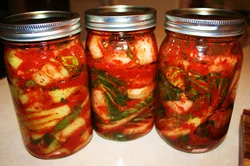One of the beautiful things about summer is opening up your fridge or pantry to a veritable cornucopia of fresh fruits and vegetables. The rainbow of colors, textures and flavors guarantees your next meal will be interesting and nutrient-dense. Snacks transform from something once bagged and crunchy, to something…. ermm green produce-bagged and hopefully still crunchy, if not juicy and tender. However, I find shopping for produce in the heat of summertime to be a little overwhelming: what seems like miles of fruit and vegetables, stacked high or portioned off in little wicker baskets, act as some sort of provisional proffering. I try to rotate between my favorites: sugar snaps peas had their moment last week, and now it’s time to give heirloom tomatoes some kitchen lovin’.
Usually, this plan fails miserably. Fresh produce extends its proverbial hand out to me, and I willingly latch on, arriving home with much more than I initially anticipated. With my produce drawer full, I struggle to create some sort of fridge symbiosis: heavier vegetables trying not to crush the bunches of herbs I’ve crammed into the same shared space, and plums avoiding the usual bruise-and-tumble that comes with this kind of disarray. My next step is usually devising a strategy that allows me to enjoy everything in a timely enough manner to avoid spoilage. Aside from the go-to chopped salads and general daily fruit-grazing, pickling is a go-to technique when I (purposely or not) have been heavy-handed at the market.
Put simply, “pickled” refers to any food that has been soaked in a solution, usually a brine of acid, salt and sometimes sugar. The brine changes the pH environment of the food to a level where mold is unable to survive. If properly done, pickled treats can be preserved in the fridge for months.
Pickling can aptly be broken down into two categories: quick-pickles and fermented foods. Quick-pickles are the result of marinating fruits and vegetables in an acid, usually vinegar, yielding a sour and often salty flavor. Quick-pickles are most commonly seen in cucumber form, maybe straddling half a sandwich, or speckled with a smattering of mustard seed and dill. Unlike canning to preserve foods, pickling does not require that a food be completely sterile before it is jarred, which is great for those who do not possess the patience to meticulously clean and boil jars and fresh fruits. The acidity of the pickling solution, the lack of oxygen, and the cold temperature should be enough to keep mold from flourishing and spoiling your unmarred produce.
A slower alternative to the quick-pickle is the process of fermentation. Instead of adding a pre-fermented solution like vinegar to food stuffs, vegetables or fruits marinate in a simple brine of salt and water, eventually creating their own lactic acid. Perhaps the most familiar lacto-fermented food in the states is sauerkraut, although the spicy Korean condiment kimchi has become ubiquitous in recent years. When fermenting, produce should be cleaned just to the point of removing visible dirt and debri, as the bacteria already present on the fruit or vegetable’s skin is necessary to create the acidic environment needed to mimic the effects of vinegar. When fermenting, be sure to carefully follow a recipe: this process is more meticulous than that of the quick-pickle, and accidentally leaving a jar on the counter a room temp for too long could create enough carbon dioxide to blow off the lid.
Since traditionally lacto-fermented foods act as probiotic that increases the good bacteria in our intestines, many Eastern cultures regularly include fermented foods into their diets by serving them alongside meals as a digestive aid. Eating fermented foods may seem primitive in the face of the modern pasteurization we are used to today, but consuming small doses of good bacteria is important for the strengthening of our immune system.
I see at-home pickling is an invitation to ignite culinary ingenuity. Consider this an exercise in thinking outside of the cucumber (or cabbage): carrots, cauliflower, okra, and snap peas are crisp enough to stand up to a long, salty soak, but experimentation is key. Why not try heirloom cherry tomatoes, fennel or jicama? Adding some sliced serrano chile or jalapeño (go easy- just a few slices) infuse the pickles with palpable heat.
Don’t restrain your pickling to just vegetables either: any sort of stone fruit, plus firmer melons like cantaloupe and honeydew make great pickles, just be sure to cut down on the salt. I like balancing the acidity of my brine by adding a bit of sweetener, like honey, maple syrup or agave, along with warm spices such as cinnamon and cloves. This may go without saying, but just like the fresh stuff, you’ll want to choose produce that is firm, ripe, and free of brown spots. This will ultimately yield the most appetizing condiment; paramount if you plan on having a few jars hanging out in your fridge for a while.

